Trump’s tariff policies, the impact on the economy and global listed infrastructure
In a follow up to our November 2024 News & Views “Tariffs: The impact on Infrastructure” we look at the ongoing tariff developments, the potential fallout on the US and global economies, and consider the impact on global listed infrastructure sectors and stocks.
Trump’s first two months in the White House
Tariffs and immigration were two cornerstone policies of Trump’s 2024 election campaign.
The beginning of 2025 saw increasing policy uncertainty due to Trump's tariff threats, the DOGE cuts, and curbs on immigration. Optimism rose briefly in February and March as Trump delayed Mexico and Canada tariffs but maintained others, like on China, and the automotive, steel and aluminium industries.
Meanwhile, US economic growth weakened, with retail sales, personal spending, and consumer and business confidence all falling. US consumer sentiment hit a 2 ½ year low in March while expectations around inflation haven’t been this high since 1993.
Shift in US Consumer sentiment and inflation expectations
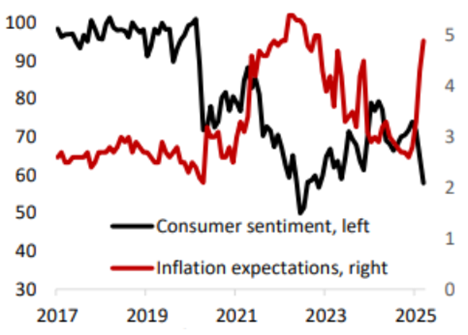
Source – University of Michigan, DBS
Thus far, the labour market and corporate earnings are strong despite weakening economic data. However, cost pressures are rising, putting the Fed in a difficult position as inflation may increase. Manufacturing activity has slowed, suggesting the recent uptick was temporary ahead of the anticipated tariffs, and not a sustained recovery.
This economic deterioration in the US led the market to question the resounding ‘US exceptionalism’ thematic that has been in play since Covid, with a particular focus back to Europe. This shift was further fuelled by Trump's undermining of NATO which led to European unity not seen in decades, and fiscal stimulus, including increased defence spending and infrastructure investment.
Positive Eurozone economic surprises while US surprised to downside
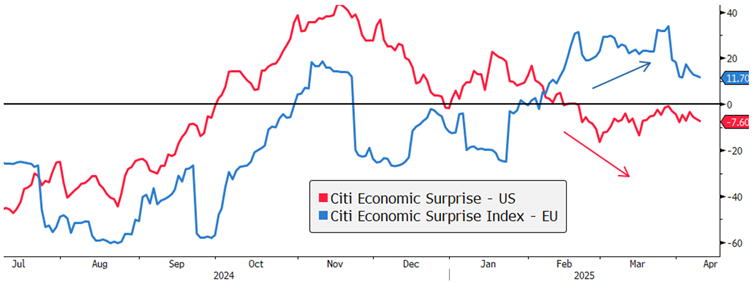
Obliteration Day
All of this was just the heat before the main event: April 2, Trump’s so-called ‘Liberation Day’, which turned out to be ‘Obliteration Day’.
The announced tariffs were far more aggressive than most bear cases, with a 10% Universal Base Tariff (as expected), very high reciprocal tariffs on 27 countries and the EU bloc, as well as ending De Minimis exemptions (which allow duty free goods entry under $800 USD, typically from China and Hong Kong). To their great relief, Canada and Mexico were left off the reciprocal tariff list.
Country-level Liberation Day Tariffs
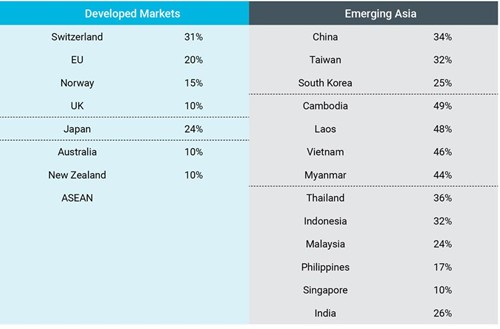
Trump also left the door open to rate changes and additional sector-based tariffs. Some countries received the minimum reciprocal tariff of 10%, including Brazil, UK, Singapore, Australia and New Zealand. The Nomura Research Institute [1] noted:
“After World War II, the United States championed the promotion of free trade to prevent a repeat of past mistakes. However, the Trump administration is now significantly shifting this policy, threatening to dismantle the global free trade system. This shift will likely reduce economic efficiency and slow global growth.”
Cumulative change in US average tariff

The unexpectedly severe tariffs, with no exemptions and a short timeframe, shocked the markets. The S&P500 and Nasdaq fell over 10% in the following days. Bond yields, after initially falling to below 4%, rallied aggressively with US ten year bonds hitting 4.5%, the steepest two day move in yields in two years.
The increase in longer term yields, while shorter term yields stayed low with the expectations of more Fed cuts, was what was most troubling to the market – a repricing of the US term premium, with the market demanding a higher premium for the level of economic uncertainty, large fiscal debt and deficits long term.
Vulnerabilities from proposed reciprocal tariffs
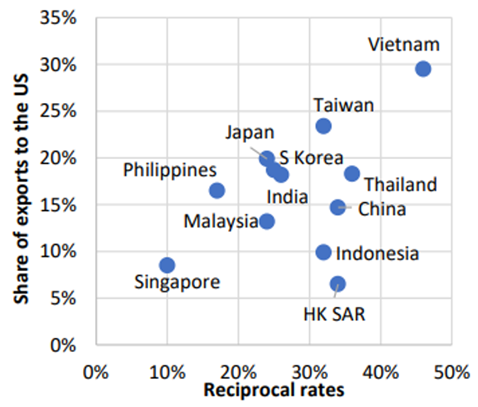
The level of retaliatory tariffs from other countries are expected to have a major impact on US trade flows, growth and inflation.
The US and China have imposed escalating retaliatory tariffs on each other. These now stand at 84% for the US and 145% for China - the reality is that these figures are quite irrelevant, given trade between the two countries is likely to cease under either scenario.
Trump's 90-day tariff pause on April 9, excluding China, caused a market rally, but economic and geopolitical risks remain. In particular:
- Minimum 90 days of tariff-led volatility and an inability for companies to make any forward strategic decisions in that time.
- The success of negotiations between countries and the US, particularly the heavily taxed ASEAN nations (that could absorb some Chinese exports).
- The level of sector and company carve outs (if any).
- A permanent elevated risk environment with continual policy uncertainty
- Details on how tariff revenue will be used to fund tax cuts and deregulation.
- Potential legal or Congressional challenges from the tariff process (not seen as likely, but could delay).
- Trump’s responsiveness to market and/or real economy weakness
- Investor confidence during Trump's term.
The macroeconomic impact of tariffs on countries – Scenarios
In our November 2024 News & Views “Tariffs: The impact on Infrastructure”, we stated “On their own, tariffs are broadly negative for US growth, boost inflation and put the Fed on hold (or on a slower path down).” The Liberation Day announcement led to much more aggressive downgrades of US growth, upgrades to US CPI and a bring-forward of Fed cuts.
- The market forecast changed from two Fed cuts to five as CPI increases and labour market outlook weakens.
- GDP forecasts were cut to 1-2%, and US CPI was increased to 3.5-4%. Inflation would negatively impact household income and consumption.
- US recession odds increased to 40-50%. Tariffs would lower household consumption and business sentiment.
The worst-case downgrade predictions may be lessened as Trump retreats from imposing reciprocal tariffs. However, we foresee three possible tariff outcomes and their macroeconomic impact:

The effect on regional economies depends on future negotiations, but some are more vulnerable than others due to their economic structure and trade relationships. China and Europe are best positioned to retaliate.
Wolfe Leverage Index – Who has the most leverage to fight back?

A brief summary of main impacts of tariffs across the globe:

Besides the 90-day pause and tariff uncertainty, there are also long-term and structural impacts to consider.
- Reorganisation of global supply chains between US and China, and a trend away from the US.
- Risk of loss of confidence in the USD and less demand for US treasuries, impacting capital flows and funding their fiscal deficit.
Impact on global listed infrastructure
Infrastructure has characteristics which support long term visible and resilient earnings streams. These characteristics should prove attractive relative to broader equities in very uncertain economic and geopolitical environments. Further, infrastructure is quite unique in that within our universe, we have macro diversity as well as regional diversity. As such we can actively position a portfolio with consideration of in-country macro drivers to fundamentally weather the evolving economic and geopolitical environment. That is not to say however, that this environment poses no threat to the asset class. In our November 2024 News & Views “Tariffs: The impact on Infrastructure”, we stated:
“Infrastructure stands at the crossroad of global trade – ports allow for the movements of goods across the seas, while goods are moved from ports to demand centres by railway and road infrastructure. Tariffs also have a potential impact on countries’ growth and inflation outlook, which impacts the macroeconomic variables driving infrastructure’s long-term return outlook.”
Trump’s Liberation Day announcements were detrimental to pretty much every segment of the market, including infrastructure, with few absolute winners within our universe. On a relative basis, we expected infrastructure to be more resilient but the economic consequences would have been felt. Thankfully, by implementing a 90 day pause and indicating a willingness to negotiate directly with countries, it would appear Trump has stepped back from the most extreme action, increasing the likelihood of our base case (above) eventuating, a clear improvement on the Liberation Day worst case outcome (bear case above).
Relative impact per infrastructure sector
The impact to infrastructure is very nuanced and we will publish detailed analysis on each sector in a later piece. However, in summary, the relative attractiveness of sectors/regions within the infrastructure universe are summarised below for our base case and again for the bear case – should the situation deteriorate.
Relative exposure (red) versus relative protection (green) within the listed infrastructure universe
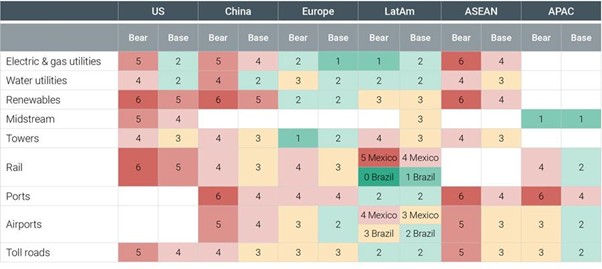
Broadly speaking a deterioration of our base case to the bear case would lead to more pronounced negative outcomes among key sectors including:
- US: Rail is impacted the most (with intermodal the most directly linked to trade and weaker domestic consumption), while Renewables are impacted by offshore supply chains and uncertainty over IRA repeals. Utilities are impacted by some pull back in growth expectations (AI upside), but generally should have resilient earnings even in recessions. However, the Fed quandary of cuts versus hikes, and the steepening of the yield curve, puts Utilities and Renewables most at risk.
- China: Ports are most heavily impacted (changing trade patterns), particularly as related to the ASEAN relationship, while Airports will be impacted by an international spending slowdown. The level of fiscal support should offset some impact on overall GDP sensitive sectors, such as Toll Roads, while Electric & Gas utilities with the highest industrial exposure will feel the greatest impact.
- UK/Europe: Impacted to a lesser extent, with the internationally exposed businesses hit most but still relatively better off than the US and China (ie international passengers at airports, offshore renewable investment plans). Also, could benefit from a reallocation of trade.
- LatAm: Brazil and Mexico very different players in these trade wars. Brazilian toll roads, rail and port companies exposed to potentially higher commodity demand from China could benefit while those airports that are predominantly domestic traffic are more protected. Brazilian utilities could also benefit from a shift in data centre demand onshore given issues facing the US. By contrast, Mexican rail is highly exposed while the airports are fragmented based on relative exposure to US versus domestic passengers/cargo, exposure to Mexican onshoring and associated FX implications.
It should also be noted that we believe a negative infrastructure outlook should still be relatively better than many sectors in the market, where earnings are not underpinned by the key characteristics that makes infrastructure resilient (monopolistic, contracted or regulated, inflation hedged).
Conclusion
In our 2025 Outlook piece we commented that predicting Trump’s every move was “a fool’s game”. Sadly, that has proven to be true with recent actions creating significant market and macro uncertainty. Unfortunately, we see no great clarity over Q2 with Trump’s actions highly unpredictable.
Fundamentally, infrastructure earnings should hold up relatively well, however, we recognise that there are many near term sector nuances. In this piece we have tried to articulate the high level risks and opportunities across the globe at a macro level and the relative attractiveness of sectors/regions within our infrastructure universe.
While the situation remains very fluid, our recent analysis supports our current overweights to Europe and parts of Latin America and an increased appreciation of defensive sectors with strong yields. We will continue to monitor the global macro, regional and sector impacts and position the portfolio accordingly within the highly diverse infrastructure universe.


This is an abridged version of 'News & Views: Are we there yet?!'. You can read the full article here.

2 topics
2 funds mentioned
